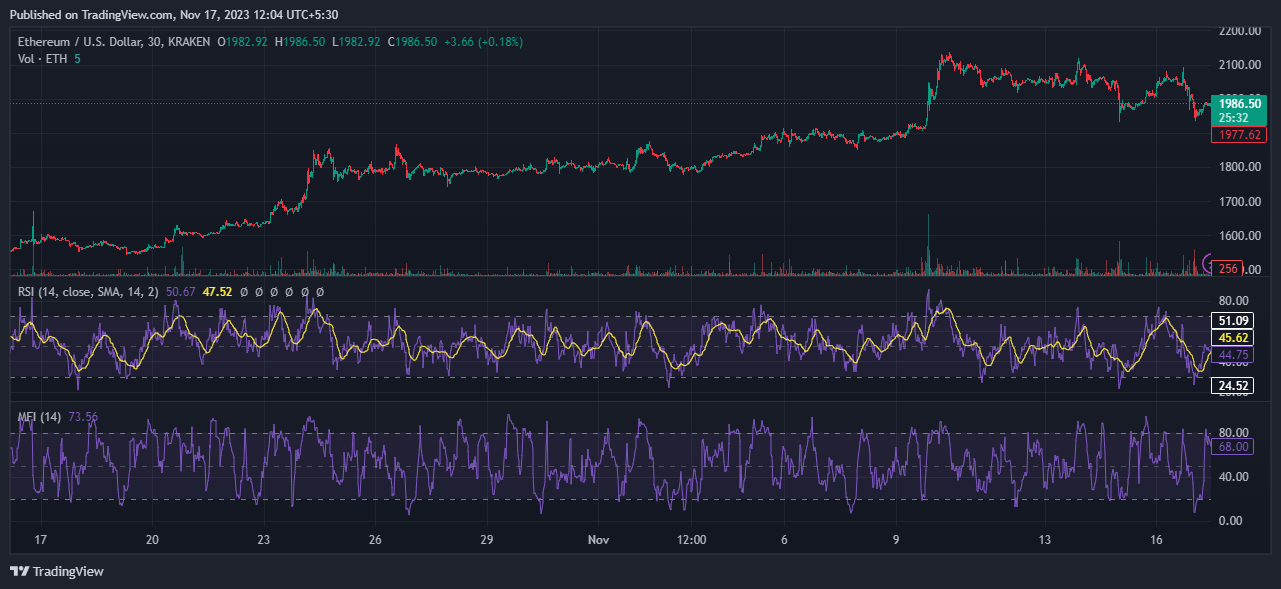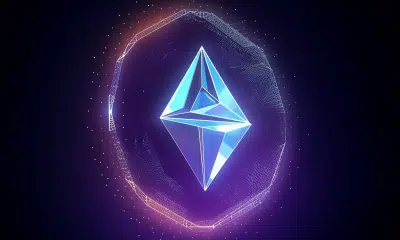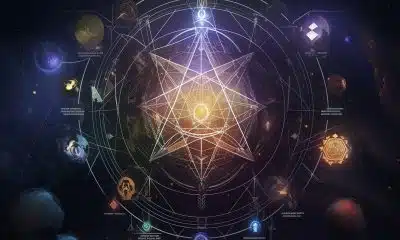Here’s what ChatGPT expects from Ethereum for 2024

Disclaimer: The information presented does not constitute financial, investment, trading, or other types of advice and is solely the writer’s opinion.
The last seven days witnessed some significant developments amid the ongoing bull run.
On 15 November, asset management giant Blackrock’s spot Ethereum [ETH] exchange-traded fund (ETF) application officially made its way to the U.S. Securities and Exchange Commission’s (SEC) desk.
The same day, the SEC notified that it had delayed its decision to approve the rule change requested by Grayscale Investments to convert its Ethereum fund to Futures Ether ETF. The SEC now has until 1 January 2024 to make a decision. It was in September that the asset manager had filed for the change.
The anticipation around ETFs has certainly led to a wild price rally on the charts. It has, however, led many to question how far such developments could adversely affect the decentralized model of the underlying blockchain technology of the crypto market. This is the reason why AMBCrypto too has looked at what’s in the future for Ethereum.
How it began and subsequently split
A child of Vitalik Buterin, the Ethereum blockchain network was first explored in a whitepaper in 2014. His colleagues on the project included Gavin Wood, Charles Hoskinson, Anthony Di Iorio, and Joseph Lubin.
Subsequently, the team founded a Swiss non-profit foundation, the Ethereum Foundation (Stiftung Ethereum). The project was launched in 2015.
Ethereum was created with the goal of being scalable, programmable, secure, and decentralized. It natively supports smart contracts, a key component of decentralized apps. Smart contracts, in tandem with blockchain technology, enable a large number of decentralized finance (DeFi) applications.
Users can also generate and exchange non-fungible tokens (NFTs), which are tokens that can be linked to specific digital assets such as photos. Furthermore, several other cryptocurrencies use the ERC-20 token standard on top of the Ethereum blockchain and have used it for initial coin offerings.
Only a year after its launch, the project split into Ethereum and Ethereum Classic [ETC].
What happened was that in 2016, a group of network participants gained majority control of the Ethereum blockchain to steal ether worth more than $50 million which had been raised for a project. Most of the Ethereum community opted to reverse the theft by invalidating the existing Ethereum blockchain and approving a blockchain with a revised history—Ethereum.
However, a fraction of the community chose to maintain the original version of the Ethereum blockchain. The unaltered version of the blockchain permanently split to become Ethereum Classic.
The event came to be known as the Hard Fork.
The Merge and the Shapella
Ethereum initially employed the proof-of-work (PoW) consensus mechanism. It required energy-intensive computing referred to as mining to validate blocks.
Owing to criticism around the mechanism’s environmental impact, the project transitioned to proof-of-stake (PoS) consensus mechanism in September 2022. The event came to be known as the Merge.
It is critical at this juncture that we understand what both these mechanisms are and how they differ.
A consensus mechanism consists of the rules and protocols that govern how a blockchain network reaches an agreement on its state. The two most popular mechanisms are PoW and PoS.
PoW requires the utilization of computational power by miners to solve challenging mathematical riddles and validate transactions. The first miner who solves the challenge receives fresh coins and transaction fees. Although it is though to be more secure and decentralized, it also uses a significant amount of energy and resources.
Instead of requiring miners to solve problems, PoS requires validators to stake some of their coins as collateral. The network then chooses a validator at random to construct a new block depending on stake size and other parameters. The validator is compensated with transaction fees rather than fresh currencies.
PoS is considered more scalable and energy-efficient than PoW.
At press time, a total of 28,195,445 ETH tokens were staked, valued at $55.6 billion.
ETH is the second-largest cryptocurrency in the world, with a market cap above $233 billion.
A recent CoinGecko report put Ethereum as the top Layer-1 (L1) blockchain. Its total value locked (TVL) stood at $23.0 billion in October 2023.
In 2023, it reached its yearly peak TVL of $31.5 billion in April. This was shortly after the Merge.
At this point, we decided it’s a good time to solicit ChatGPT, the pioneering AI bot, for critical advice on these developments.
ChatGPT has proven to be valuable for traders and analysts. I spoke to ChatGPT about these development while touching a bit on ETH’s price.
At first, ChatGPT wasn’t able to provide any details. So I decided to educate and jailbreak it.
We then asked it about the impact of the Merge on Ethereum’s price.

Source: ChatGPT
The bot told me that the Merge catalyzed a surge in demand and confidence. Its response was not a departure from real-time data.
In April 2023, Ethereum’s Shanghai hard fork, also referred to as Shapella, got finalized. The upgrade allowed users to unstake their ETH tokens for the first time since December 2020.
Notably, the Shapella is a combination of the Shanghai and Capella upgrade. The Shanghai upgrade takes place on the execution level, while Capella takes place on the consensus level.
The upgrade was the most significant development of the second-largest blockchain since the Merge.
Is Ethereum a commodity or a security?
Similar to most cryptocurrencies, there has been a lot of debate over the fact whether Ethereum is a commodity or a security.
In a critical Uniswap court case, the judge ruled in August that ETH is a commodity. The SEC has shied away from doing so even if it hasn’t gone after ether like other tokens.
Recently, Bloomberg analyst James Seyffart underlined the SEC’s unsaid stance over the issue.
Even if SEC won’t explicitly claim ETH to be a commodity in the way that they do for Bitcoin. They have implicitly accepted its commodity status for years. Huge shoutout to @SGJohnsson who has been critical in forming some of my views on this topic. https://t.co/vLq2abeJNO
— James Seyffart (@JSeyff) November 16, 2023
However, we should also take note of any non-explicit classification so far. The stance of regulatory bodies has also evolved with years, with courts intervening time and again.
I asked ChatGPT about Ethereum’s future performance
Ethereum has slowly emerged as one of the most prominent blockchain networks. As ideated, it supports a large number of L2 blockchains. The TVL of Ethereum-based L2 networks recently surged to an all-time high, surpassing $13.8 billion
? The Total Value Locked (TVL) in all #Ethereum Layer 2 networks has surged to an all-time high, surpassing $13.8 billion.
? @Arbitrum takes the lead with TVL of $7.5 billion.https://t.co/5mn1kjq991 pic.twitter.com/Vr4GOgVPGX
— GN Crypto ?? (@GNcrypto_news) November 16, 2023
Thanks to the recent bull run, ETH has been trading around the $2,000-mark for the past few days. At press time, ETH was exchanging hands at $1,986.50.
While Ethereum’s Relative Strength Index (RSI) rested below the neutral 50-mark, its Money Flow Index (MFI) rested above it. It seemed that the bears and bulls are engaged in a tug of war in regard to ETH.
We then asked ChatGPT to predict Ethereum’s price towards the end of the first quarter in 2024.
It forecasted ETH’s price to git $7,000 by the end of Q1 2024. In essence, it expected ETH to surge more than 3x during the next five months — an extraordinary expectation, to be frank.
Next, we asked it what it thinks of ETH’s price by the end of the next year.
The bot told me that it predicted ETH to reach $10,000 by the end of 2024. It expected the cryptocurrency to rise 5x over the next year.
While it is a very high expectation, we shouldn’t outright dismiss it. We are yet to see the wider implications of the ETFs on the crypto market. It is quite possible it might lead to wider adoption, leading to a surge in token prices.
Is your portfolio green? Check out the ETH Profit Calculator
Conclusion
Following the encounter with ChatGPT, I must admit that it may be a good idea to leverage its capabilities. As technology develops, so does its potential to revolutionize the cryptocurrency ecosystem.
Besides, there has been a slow rate in the network growth of several crypto projects recently. But with ChatGPT available, crypto education and adoption could improve.
More importantly, you may want to take its “classic” response a little seriously.
As far as Ethereum’s price analysis and prediction are concerned, ChatGPT turned out to be a reliable ally. You only need to interact with it enough and it will guide you to the moon.
While ChatGPT predicts ETH to hit the price of $10K by the end of 2024, its on-chart metrics don’t suggest a bull run.










